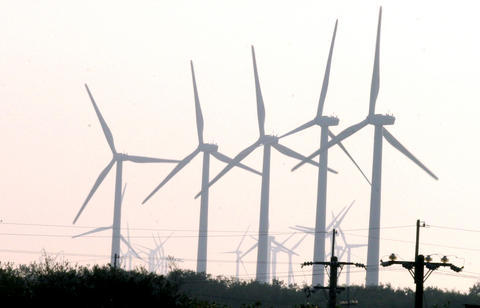The number of wind turbines along the west coast is now more than 100 and the renewable energy generated by these units should be sufficient to prevent emissions of 250,000 tonnes of carbon dioxide every year, energy officials said yesterday.
During a ceremony at the Changhua Coastal Industrial Park to promote the use and efficiency of wind power, officials from the Bureau of Energy under the Ministry of Economic Affairs said the 103 giant wind turbines located at 13 wind farms along the west coast can generate 420 million kilowatt-hours of electricity a year -- enough energy to power as many as 105,000 households.
The windmills were established by Taiwan Power (Taipower), the private-run Tien-Lung Paper and InfraVest Wind Power Group, a German company that entered the market in 2000 as the first wind farm builder in Taiwan.

PHOTO: CNA
Officials said that more windmills are under construction in western coastal areas and Penghu, with an additional total capacity of 500 megawatts.
Each unit will cost at least NT$100 million (US$3 million) to build.
They said the coastal areas are ideal for the development of wind power, as they enjoy six months of strong northwesterly winds every year, with an average wind speed of 5 meters per second to 6 meters per second.
The Bureau of Energy has set the target of generating enough renewable energy to meet 10 percent of the country's electricity needs by 2010, with wind power making up 80 percent of the renewable energy.
Taipower, the sole electricity supplier in the country, began to harness wind energy in 2002 and plans to establish 200 wind turbines in Taiwan proper and Penghu by 2010.
Taipower's long-term wind power development plant will build an additional 546 wind turbines between 2010 and 2020 in shallow waters off the west coast and Penghu, with a total capacity of 1,980 megawatts.
The estimated cost for the wind turbines is NT$200 million each.
Out of the 546 windmills, 176 will be built off Penghu and the electricity generated by these units will be relayed to Taiwan through a 40km-long undersea cable.
The other 370 units will be established 10km to 15km off the coast of Changhua and Yunlin counties, Taipower said.

Beijing could eventually see a full amphibious invasion of Taiwan as the only "prudent" way to bring about unification, the US Department of Defense said in a newly released annual report to Congress. The Pentagon's "Annual Report to Congress: Military and Security Developments Involving the People's Republic of China 2025," was in many ways similar to last year’s report but reorganized the analysis of the options China has to take over Taiwan. Generally, according to the report, Chinese leaders view the People's Liberation Army's (PLA) capabilities for a Taiwan campaign as improving, but they remain uncertain about its readiness to successfully seize

Taiwan is getting a day off on Christmas for the first time in 25 years. The change comes after opposition parties passed a law earlier this year to add or restore five public holidays, including Constitution Day, which falls on today, Dec. 25. The day marks the 1947 adoption of the constitution of the Republic of China, as the government in Taipei is formally known. Back then the Chinese Nationalist Party (KMT) governed China from Nanjing. When the KMT, now an opposition party in Taiwan, passed the legislation on holidays, it said that they would help “commemorate the history of national development.” That

Taiwan has overtaken South Korea this year in per capita income for the first time in 23 years, IMF data showed. Per capita income is a nation’s GDP divided by the total population, used to compare average wealth levels across countries. Taiwan also beat Japan this year on per capita income, after surpassing it for the first time last year, US magazine Newsweek reported yesterday. Across Asia, Taiwan ranked fourth for per capita income at US$37,827 this year due to sustained economic growth, the report said. In the top three spots were Singapore, Macau and Hong Kong, it said. South

Snow fell on Yushan (Jade Mountain, 玉山) yesterday morning as a continental cold air mass sent temperatures below freezing on Taiwan’s tallest peak, the Central Weather Administration (CWA) said. Snowflakes were seen on Yushan’s north peak from 6:28am to 6:38am, but they did not fully cover the ground and no accumulation was recorded, the CWA said. As of 7:42am, the lowest temperature recorded across Taiwan was minus-5.5°C at Yushan’s Fengkou observatory and minus-4.7°C at the Yushan observatory, CWA data showed. On Hehuanshan (合歡山) in Nantou County, a low of 1.3°C was recorded at 6:39pm, when ice pellets fell at Songsyue Lodge (松雪樓), a